ASUS P8Z77-V Premium Review: A Bentley Among Motherboards
by Ian Cutress on August 13, 2012 10:30 AM EST- Posted in
- Motherboards
- Asus
- Z77
3D Movement Algorithm Test
The algorithms in 3DPM employ both uniform random number generation or normal distribution random number generation, and vary in various amounts of trigonometric operations, conditional statements, generation and rejection, fused operations, etc. The benchmark runs through six algorithms for a specified number of particles and steps, and calculates the speed of each algorithm, then sums them all for a final score. This is an example of a real world situation that a computational scientist may find themselves in, rather than a pure synthetic benchmark. The benchmark is also parallel between particles simulated, and we test the single thread performance as well as the multi-threaded performance.
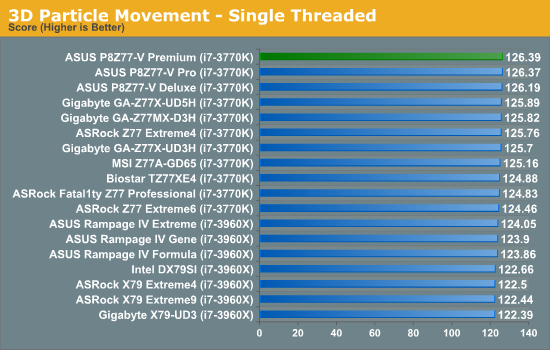
Despite all the Z77 motherboards being at the same CPU speed in our 3DPM single threaded test, the ASUS P8Z77-V Premium comes out on top with our two other ASUS motherboards.
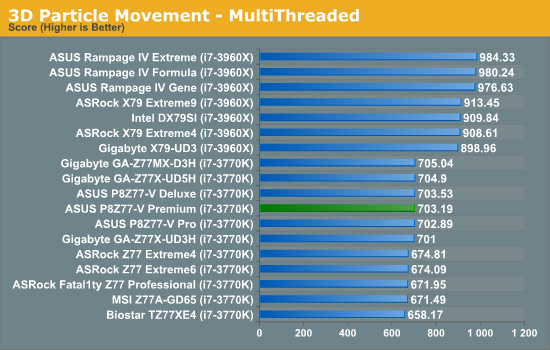
The ASUS P8Z77-V Premium benefits from MultiCore Enhancement in multithreaded testing, which allows the processor to remain at the top turbo bin (39x multiplier) during any load. This gives the Premium (and other ASUS/Gigabyte boards) an advantage in this testing.
WinRAR x64 3.93 - link
With 64-bit WinRAR, we compress the set of files used in the USB speed tests. WinRAR x64 3.93 attempts to use multithreading when possible, and provides as a good test for when a system has variable threaded load. If a system has multiple speeds to invoke at different loading, the switching between those speeds will determine how well the system will do.
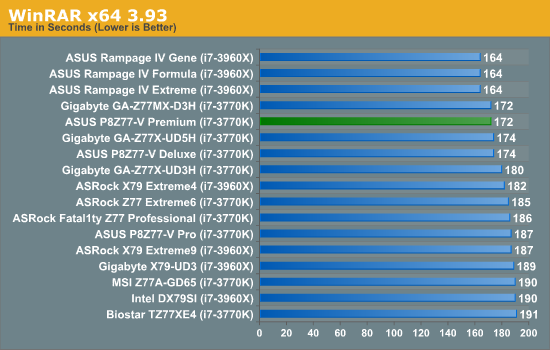
The MultiCore Enhancement of the Premium gives us the joint top Z77 score in our WinRAR test. However, the extra cores and MCE of the ASUS X79 Rampage boards still come out ahead.
FastStone Image Viewer 4.2 - link
FastStone Image Viewer is a free piece of software I have been using for quite a few years now. It allows quick viewing of flat images, as well as resizing, changing color depth, adding simple text or simple filters. It also has a bulk image conversion tool, which we use here. The software currently operates only in single-thread mode, which should change in later versions of the software. For this test, we convert a series of 170 files, of various resolutions, dimensions and types (of a total size of 163MB), all to the .gif format of 640x480 dimensions.
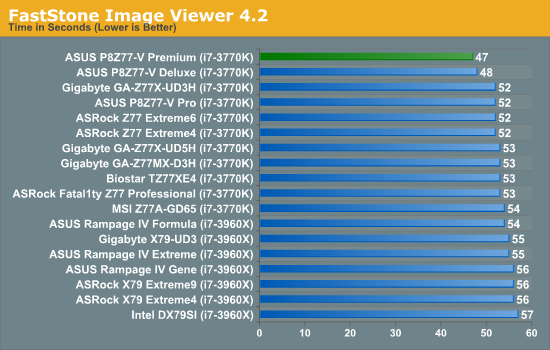
In line with our 3DPM testing, it seems like the ASUS P8Z77-V Deluxe and Premium both have a default algorithm that maintains higher multipliers during single threaded testing. As a result, we have a new top time in our FastStone testing with the Premium at 47 seconds.
Xilisoft Video Converter
With XVC, users can convert any type of normal video to any compatible format for smartphones, tablets and other devices. By default, it uses all available threads on the system, and in the presence of appropriate graphics cards, can utilize CUDA for NVIDIA GPUs as well as AMD APP for AMD GPUs. For this test, we use a set of 32 HD videos, each lasting 30 seconds, and convert them from 1080p to an iPod H.264 video format using just the CPU. The time taken to convert these videos gives us our result.
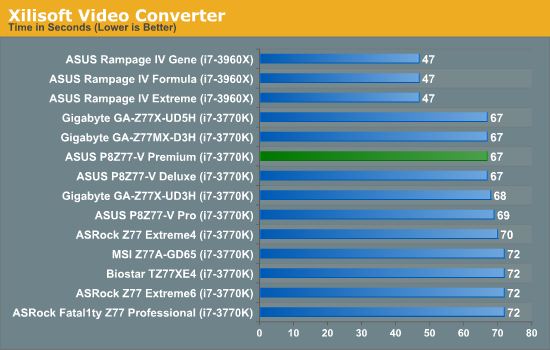
As XVC loves cores and MHz, the Premium and other MultiCore Enhancement boards do very well compared to other Z77 motherboards. X79 still reigns supreme by having more cores and higher memory bandwidth.
x264 HD Benchmark
The x264 HD Benchmark uses a common HD encoding tool to process an HD MPEG2 source at 1280x720 at 3963 Kbps. This test represents a standardized result which can be compared across other reviews, and is dependant on both CPU power and memory speed. The benchmark performs a 2-pass encode, and the results shown are the average of each pass performed four times.
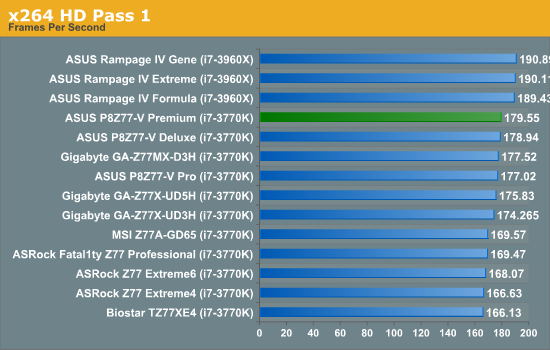
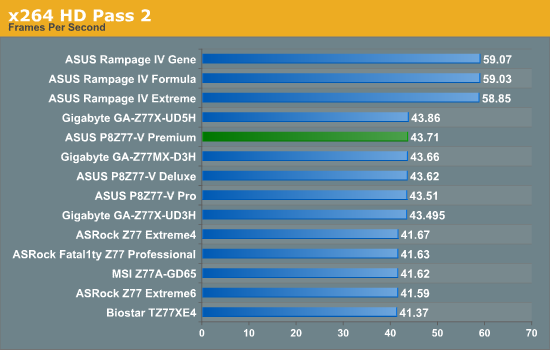
The Premium also comes top or near top in our x264 testing.










43 Comments
View All Comments
ASUSTechMKT - Tuesday, August 14, 2012 - link
It offers considerably better performance first generation 9128 and 9120 and 9130 were not bad controller just limited in peak throughput but keep in mind the controller was put to market before Intel even had SATA6G PCH. Also keep in mind performance for real world usage ( boot time, application launch performance, copy performance is pretty similar between then it is only in benchmarks you will see a measurable difference. That being noted the x2 interconnect offers twice the throughput for considerably improved performance vs the x1 interconnect 9128 type solutions. This allows newer SATA6G drives to generally perform on about the same level as the Intel PCH ( peak performance being at / near or above 500MBs on fast controllers ). Additionally it has some specific advantages not noted in the review such as stacked SSD caching. This allows up to 3 SSDs to be stacked on a mechanical drive to continue to enhance its performance.Hope this clarifies it for you.
infoilrator - Monday, August 13, 2012 - link
On any top price product certain features are necessary, useful or not, on a "has" basis.Minor omissions (in the would be nice category) would be a card reader in the front USB3.0 Device, and a PCIe expansion card with 2 firewire and 2 USB2 or USB3 plugs.
After all, too much is not enough, $450 should not require further shopping for minor add ins.
The price, if you have full use for the "package" seems acceptable, not that I'll ever have it.
TimoKyyro - Monday, August 13, 2012 - link
I would have liked to see GPU rendering benchmarks with SmallLuxGPU or Blender. This board would be perfect for animation rendering with 2 x PCIe 3.0 x16 for dual GTX 690 or 4 x PCIe 3.0 x8 for quad GTX 680.The price doesn't matter if I get faster GPU rendering and better support for new technologies like PCIe 3.0 and Thunderbolt.
IanCutress - Monday, August 13, 2012 - link
Unfortunately I do not have access to those GPUs.Ian
rahvin - Monday, August 13, 2012 - link
Are the eSATA ports port multiplier capable?mayankleoboy1 - Monday, August 13, 2012 - link
it would be great to see a PCIE3.0 SSD for tests and if it can take advantage of the extra bandwidth.DigitalFreak - Monday, August 13, 2012 - link
There is no "extra bandwidth". You're still limited to the x16 connection to the CPU.jwcalla - Monday, August 13, 2012 - link
$450???If you want to set yourself apart, how about supporting something useful like ECC RAM and 10 GbE?
Until you can do ethernet over Thunderbolt, I don't really see the point of TB on a motherboard like this.
And 10+ SATA ports... that would only be used in a file server context. But that requires ECC RAM. So it doesn't add up.
JMO.
jwcalla - Monday, August 13, 2012 - link
* Ahh yes I forgot that desktop Intel chipsets don't support ECC RAM so they can charge more for their server-based motherboards and processors.Even Cortex A-15 supports ECC. *sigh*
This space needs some serious competition. It's just the same boring features rehashed and multiplied.
Kevin G - Monday, August 13, 2012 - link
There are a few TB -> Ethernet solutions out there, including an adapter from Apple. Though with two NIC's on the board, I'm not really use-case scenario for TB on this particular motherboard. I can only fathom fast external storage and at that point the user would be better off with a solid SAS card with external connectivity.As for ECC, Intel does indeed limit their desktop processors. A handful of motherboards will support ECC if a socket 1155 Xeon is utilized. Though if ECC is critical, AMD's FX line supports ECC and up to the motherboard manufacturers to support it.